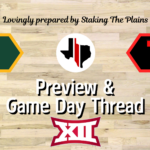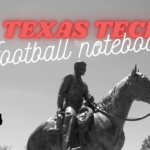New defensive coordinator Keith Patrick is set to install an odd-front 3-3-5 defense. Let’s discuss.
1. The Players
One of the things that got me thinking about trying to learn a bit more about the 3-3-5 defense is how the Texas Tech players compared to what Utah State had last year.

Before we begin, let’s keep in mind that Keith Patterson was only at Utah State for one year. Matt Wells suffered his second losing season in a row and he essentially said that he’s moving on from whatever he had, which was Kendrick Shaver adn Frank Maile as co-defensive coordinators to hiring Patterson to take over for Shaver. In fact, the Utah State defense was 42nd in defensive S&P+ in 2017 and improved to 34th in 2018. Not a huge jump, but there was improvement and there was certainly no drop-off.
But I wanted to give you a sense of how the defense compares to the starters for 2018 for Texas Tech. The thing that you’ll notice is that the three down linemen all have some heft, essentially averaging about 290 or so, while I think that’s pretty comparable for Texas Tech too. The one thing that’s perhaps a little different is that the rush end for Texas Tech and the outside linebacker for Utah State are essentially the same position, a stand-up defensive end / linebacker. If I remember correctly, I think the rush end for Texas Tech trained with the linebackers this year, so we’re essentially talking about a linebacker for both spots.
The difference between the two spots was production. The starter for USU was former TCU player-man Tipa Galeai who ended up with about 5 tackles a game, 14 tackles for a loss, 10.5 sacks, 3 passes broken up, 7 quarterback hurries and 3 forced fumbles. Kolin Hill for Texas Tech had about 3 tackles a game, 7 tackles for a loss, 5 sacks, 1 pass broken up and 5 quarterback hurries. Galeai doubled up on production and I think that’s really important to Patterson. A player that can truly pressure the quarterback. That didn’t happen enough for Texas Tech this year. I’m not sure who that is for the Red Raiders in 2019, but that’s going to be really something to watch (If I had to put money on it right now, I’d put money on Rico Jeffers being that guy).
Oh, and this spot is going to be called the “Raider” linebacker spot I think. The safety/linebacker is going to be called the “Spur”.
The “outside linebacker” spot that’s opposite of the nickelback (which was Justis Parker as the starter) should probably be a bit of a bigger player for Texas Tech in 2019 as that’s how Patterson tends to roll. A versatile player that can actually play both linebacker and safety. I haven’t done a deep dive about who that might be, but I suppose that Parker could still fill that role, but he’ll need to be a bit bigger I think.
It’s also interesting that Utah State didn’t have a huge problem going smaller at cornerback. I sort of like having bigger cornerbacks, I think that’s beneficial, but we’ll see how that goes. You obviously give up some quickness with some bigger defensive backs.
2. Be Multiple
The biggest advantage of the 3-3-5 defense is that the defense can be multiple. The defense can essentially rush 3 or rush 4 or drop 5 into coverage all within the exact same base defense.
There are exceptions, but WVU typically shows an offense a Cover 3 defense before the snap. Among the two cornerbacks and three safeties, three of those five players will drop back into coverage on a play. In a traditional defense, there are only four defensive backs and four three-player combinations for an offense to consider.
When the ball is snapped against WVU, the three defensive backs do the job they were assigned, but the 10 possible three-player combinations mean that can happen anywhere across the field.
The greatest trick, though, can be within that Cover 3 look. Gibson could show that and then play Cover 1 or Cover 0 and have just one safety or no safeties drop back into coverage. That means he’s sending pressure, and there’s only one guarantee associated with his blitz package.
“Everyone on defense there’s a blitz for except the field corner,” Gibson said, noting the field corner, who plays on the wide side of the field, has too much ground to cover to be an effective blitzer. “Everyone else, you can see them coming at one point or another.”
What distinguishes Gibson’s 3-3-5 from Casteel’s at WVU and from the others around the country is the blitzing. His pressures opponents because he wants his defense to dictate the direction of the game. Yet WVU doesn’t ask its defensive linemen to do a lot with the pass rush, and the defense usually isn’t near the top of the conference, never mind the nation, in sacks.
3. Focus on Three Things
When I took a deeper dive in looking into Patterson’s defense I felt like Patterson was essentially saying the exact same thing that West Virginia defensive coordinator Tony Gibson said in the same article quoted above:
That’s the greatest example of how Gibson chooses to views certain stats, but there are others. He won’t allow his defense to be defined by the yards it allows per game. He instead knows points matter most and circles three factors that should keep opponents from scoring. He wants to get three-and-outs, third-down stops and turnovers, all so WVU’s offense can have more possessions.
Even that can be narrowed down, though. Gibson believes games are decided on third downs. He knows the way his defense is structured with the disguised coverages and the unpredictable blitzes gives his players greater odds to win on that down.
Just watching some Utah State football from last year, it is quite obvious that Patterson loves to blitz on third down and teams will often take advantage of it to the point that they’ll start to run some misdirection or screens to counter attack Patterson’s blitzes. If you want an aggressive no-hold-barred defense, well . . . buckle up because you’re about to get a defense that loves to put the pedal to the metal, especially on third downs.
4. Attack vs. Read and React
There are two different philosophies regarding the defensive line of the 3-3-5 defense, have the defensive line stunt the lien on nearly every snap or use the defensive line as a base front and then read and react. I think that Patterson probably employs a bit of both, but probably leans to the first method more than the second method. Here’s what you’re going to need on the line if you want to run the first option:
Noseguard – The real “true defensive lineman” of the group. He’ll see plenty of double teams inside with the center and guards and he needs the strength to fend them off. He’ll be asked to play the double A gaps, so he needs to be bigger and squattier. Air Force Academy’s noseguard is in the range of 245-280 pounds, while the University of Tulsa’s man in the middle tops out at 330 lbs. Both play in the odd stack.
Defensive End (tight side) – The stronger of the two ends, mainly because teams have a tendency of running to the tight end side. He should be strong enough to handle double teams from the tight end in the power o run game. Most of these ends at the college level are LB converts, because speed is a necessity. They need to get off the ball quickly and have the ability to redirect on the snap.
Defensive End (open side) – Needs to be your best pass rushing defensive lineman. Playing away from the tight end, he’ll see a lot of option schemes and bootlegs. This is generally the most athletic d-lineman. He must be able to play well in space, especially if teams like to put their split end to the field side of the formation.
I’ll be very interested to see who gets placed in what spot moving forward.
5. Not Always Successful
The thing that struck me about Patterson was that he said all of the right things in his opening press conference. Even when things for West Virginia didn’t work out, he still appeared to have said and done the right things with the players:
“He prepares us from Sunday to Saturday morning,” defensive end Will Clarke said. “We watch a lot of film. We go over schemes a lot. It’s a lot of repetition – a lot of repetition.”Only some of that is unusual. A lot of coaches will start to whisper about the upcoming opponent the day after the last game ended. On Tuesday, coordinators share their game plan and they’re rehearsed throughout practice on Tuesday, Wednesday and Thursday. There’s film every day, too, either of the opponent or of the way preparations looked in practice.
Patterson keeps his players busy Friday at the team hotel, either in Morgantown or on the road. The defense gets together in a room to watch some more film and then Patterson gets particular.”He goes around the room and makes us stand up and state what we should do on certain plays and when we see certain formations,” Banks said. “He goes by position. That helps us a lot because you know what everyone else knows.”The Mountaineers sleep on that, but get together one last time before they leave the hotel for the game.
Patterson reviews the opposition’s tendencies and reminds players who and what to take away during certain plays.”Then he shows us more film and he usually gives us a nice speech that gets our blood boiling,” Banks said. “He keeps us prepared. He keeps us on our toes.”The Friday night activity isn’t new, though Patterson’s inquisitiveness has opened eyes among players and makes them make sure they aren’t without answers if their names are called.
The Saturday sessions are new, but so are these results to many of the players.Young or old, they realize it’s all connected.”I just feel he’s a good person, a good motivator,” Cook said. “I feel like since he tries so hard for us a lot of people want to give everything for him. We know how much he really cares. He reassures you. Every week he tells you he loves you and cares about you and you can see it. It’s really good just playing for him.”
This all sounds exactly what you want from a defensive coordinator. I haven’t gotten into the downfall of Patterson other than the yards and the lack of turnovers tend to rear their ugly head. Turnovers can’t be taught, but Patterson seems to have done a pretty good job of getting those turnover results.










